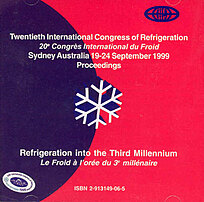
IIR document
Recent progress of advanced refrigeration systems R&D in Japan.
Author(s) : KURIYAMA T.
Summary
This paper describes recent progress on cryocoolers and their applications in Japan. The main progress in cryocoolers in the past decade is a 4 K cryocooler using magnetic regenerator materials. In 1998, two Japanese research groups achieved almost simultaneously a minimum temperature of 4 K by use of a Gifford McMahon (GM) cryocooler. Now 4 K-GM cryocoolers are commercially available from several Japanese cryocooler companies. Spherical magnetic regenerator materials, such as Er3Ni or HoCu2, are also distributed from Japan. By using a 4 K-GM cryocooler and a high Tc superconducting current lead, developed around 1990, a conductive cooled superconducting magnet (SCM) has been produced. The SCM, which does not use any liquid cryogen, is now quite popular for both research and industrial use. The magnetic regenerator materials were also applied to a 4 K-pulse tube cryocooler and to a GM/Joule-Thomson cryocooler for the magnetically levitated train.
Available documents
Format PDF
Available
Public price
20 €
Member price*
Free
* Best rate depending on membership category (see the detailed benefits of individual and corporate memberships).
Details
- Original title: Recent progress of advanced refrigeration systems R&D in Japan.
- Record ID : 2000-1135
- Languages: English
- Source: 20th International Congress of Refrigeration: Refrigeration into the Third Millennium.
- Publication date: 1999/09/19
Links
See other articles from the proceedings (447)
See the conference proceedings
Indexing
- Themes: Small-scale cryogenic applications, cryocoolers
- Keywords: Japan; Gifford-McMahon; Regenerator; Research; Material; Magnetism; Cryocooler; Cryogenics
-
Great progress in magnetic regenerator material...
- Author(s) : LI R.
- Date : 1998/04/21
- Languages : English
- Source: Cryogenics and refrigeration. Proceedings of ICCR '98.
View record
-
Entwicklung eines leistungsfähigen Gifford-McMa...
- Author(s) : LANG A., HÄFNER H. U.
- Date : 1996/11/20
- Languages : German
- Source: DKV-Tagungsbericht 23. 1996 Leipzig.
View record
-
Counter-flow pulse-tube refrigerators.
- Author(s) : WILL M. E., ZEEGERS J. C. H., WAELE A. T. A. M. de
- Date : 2002/07/22
- Languages : English
- Source: Proceedings of the nineteenth International Cryogenic Engineering Conference. ICEC 19.
View record
-
A neodymium plate regenerator for low-temperatu...
- Author(s) : CHAFE J. N., GREEN G. F., HENDRICKS J. B.
- Date : 1996/06/25
- Languages : English
- Source: Cryocoolers 9. Proceedings of the International Cryocooler Conference.
View record
-
Leistungsfähiger Einstufiger Gifford-McMahon Re...
- Author(s) : FIEDLER A., HÄFNER H. U.
- Date : 1996/11/20
- Languages : German
- Source: DKV-Tagungsbericht 23. 1996 Leipzig.
View record
